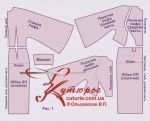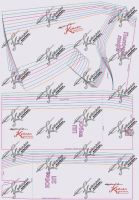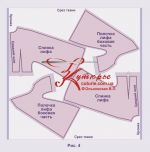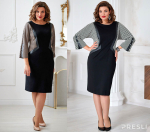Size charts What is the height of the pattern Payment methods Ask a question Reviews
PDF pattern for printing on a printer or plotter in full size for dress sizes from 40 to 54.
How to sew a dress according to Eva Green's bat kimono pattern with your own hands
Read this guide:
- A set of patterns for a dress, style, fabric.
- How to download and print bat kimono dress patterns.
- How to cut a dress according to a pattern with your own hands:
Download bat dress kimono pattern Eva Green
Fabric for a kimono bat dress, a set of patterns and a description of the style
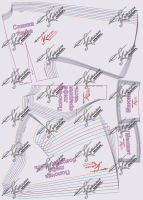 Electronic pattern of "Eva Green's dress" of a direct silhouette.
Electronic pattern of "Eva Green's dress" of a direct silhouette.
Sizes: 40-54 (buyer receives ALL sizes from 40 to 54).
File format for download in order:
PDF in full size and without seam allowances.
After paying for the order, you will receive links to download two files dress patterns gradation sizes from 40 to 54:
- PDF file A4, adapted for printing patterns on sheets of A4 paper in any program on any device, including mobile phones.
- Multi-format PDF file for printing on sheets of any size from A0 to A4 on a printer or plotter using Adobe Reader.
Sewing difficulty level is medium. You will need skills in working with thin fabrics and experience for trying on.
This style of batwing kimono dress is suitable only for slender girls with a thin waist and narrow hips.
A set of patterns for sewing a bat kimono dress with your own hands
- back patterns - bodice and back half (RF) of the skirt;
- shelf patterns - bodice shelf (one-piece), the middle part of the bodice of the shelf, the side of the bodice of the shelf and the PP skirt;
- cuff pattern.
see sketch patterns for bodice patterns kimono dresses or Eva Green's batwing.
Also, sketch patterns for skirt patterns in a kimono dress bat Eva Green
After printing a PDF file of a pattern on a printer and assembling it with your own hands, you will get patterns for sewing a dress, as in sketches, but only in full size. The templates have all the marks to cut out the details for your dress size and additional marks to cut and model this dress for yourself. instructions below.
Fabric consumption for the dress:
- thick fabric from 140 - 150 cm, with a width of 140 - 150 cm;
- transparent fabric about 120 cm, with a width of 140 - 150 cm.
For sewing this dress, both dense silk and dress wool are suitable. Organza is best suited as a transparent companion, since a certain rigidity is needed for the transparent parts of the dress. Chiffon can also be used, but in this case the look of the product will be different.
How to download, print and assemble do-it-yourself patterns
How to buy an electronic pattern
How to print a pattern life-size at home on A4 sheets
How to assemble a pattern with your own hands after printing
How to choose a pattern size without taking measurements and using tables
Download bat dress kimono pattern Eva Green
How to cut a do-it-yourself bat kimono dress using this pattern
 The tailoring of this dress can seduce with apparent simplicity.
The tailoring of this dress can seduce with apparent simplicity.
A novice home couturier will probably think that if you do not need to tuck in a sleeve, then there is no difficulty. However, the sewing of thin transparent fabrics has certain features that can create insurmountable difficulties for inexperienced tailors.
Features of cutting and processing of facings in a bat kimono dress
 For example, the processing of the neckline in this case can be done with a stitching - a stitching, the edge of which is folded over, superimposed on the “face” of the product and fixed with a finishing line. In other words, this is a facing on the "face".
For example, the processing of the neckline in this case can be done with a stitching - a stitching, the edge of which is folded over, superimposed on the “face” of the product and fixed with a finishing line. In other words, this is a facing on the "face".
To cleanly perform this sewing operation, you will need a ready-made cardboard template in the form of a facing.
In finished form, the piping can be of different widths, but in this case, the optimal width is in the range from 2 to 4 cm.
The facing pattern and its dubbing are congruent and are cut out according to the patterns of the middle part of the bodice of the shelf and along the bodice of the back (picture 2) or on the bodice of the product after trying on.
Later, dubbing blanks should be glued onto a dense fabric and cut out with 1 cm allowances to the cuts of the joining of the facing parts and along the setting cut, depending on the properties of the fabric, 1,2 - 1,5 cm.
How to cut details from dense fabric according to the pattern of a bat kimono dress
Cutting is quite simple, but, as in other models, it assumes that when starting it, the couturier has already considered all the processing options and chose the right one.
In this case, the shoulder seams and the fastener on the back are processed with trim strips of fabric for beauty and to strengthen the seams.
The optimal width of these strips in finished form is 2 - 3 cm, therefore, in cutting with the addition of a double allowance (to bend and iron) 4,5 - 6 cm. The length should correspond to the length of the seams and for ease of processing it is better if the strips are 3 - 4 cm longer.
Now, in order:
- We fold the fabric in half face to face and, combining the edges, place them parallel to the edge of the cutting table.
- We lay out the patterns of the skirt, the middle part of the bodice of the shelf and cuffs on the fabric. Then we mark the strips for the seams, not forgetting to leave room for the facings.
- You should pay attention to several points.
- The allowance for the slot is 6 - 7 cm, and the allowance for the waist of the skirt should not be done. We leave 3 cm for the hem of the bottom, the remaining allowances - 1 cm. Above the tuck of the RFP and above the PP warehouse - "houses" with a height of 0,7 - 1 cm.
- As for the middle part of the bodice shelf, we place it on the fold, like the PP skirt. We do not add an allowance along the neck, 1 cm along the relief, and 3 cm along the waist for the convenience of trying on.
- The cuff is double, that is, you need 4 parts. Allowances for processing - 1 cm. It is important to choose the right size of the cuff, based on the volume of the forearm and the style of the cuff fastener.
How to cut transparent parts for a dress with your own hands
You probably noticed that the set of patterns includes a one-piece shelf of the bodice. It can be useful for those who want to make the bodice completely transparent and, perhaps, decorate it with embroidery.
A one-piece shelf is also suitable for those who want to make the middle part of the consignment note. Please note that in order to process the overlay, you will need a ready-made cardboard template in the shape of the part for ironing the inlay cuts.
To repeat the style, the pattern of the side of the bodice shelf is also suitable (picture 4), if the details of the shelf are planned to be grinded.
Let's dwell a little more on cutting the transparent details of Eva Green's dress.
An important point is that the back of the bodice does not fit the width of the dress organza, the width of which is 150 cm. Therefore, it should be cut in a turn.
At the same time, it is important that the grain direction in the mirror parts is the same, and that the grain and transverse threads should not coincide with the shoulder seam.
How to sew after cutting a bat kimono dress step by step for beginners
- We start after cutting with the assembly of the bodice.
- At the fitting, we will specify the length and degree of fit of the bodice according to the figure, the neckline.
- Based on this, we can process the darts (or soft folds) of the back of the bodice, the middle seam for the closure, the shoulder seams and the seams of the middle part. The seams of the middle part can be processed from above before the tuck begins (this area is marked on the drawing) and the volume of the bodice can be adjusted by narrowing the side part of the bodice.
- It’s good if the cuffs are already ready and swept in for fitting.
- The skirt is gathered like a regular pencil skirt with a vent, but instead of a tuck, a soft pleat is swept up in front. This is convenient, because after trying on the bodice, if necessary, the warehouse can be easily moved to the right place and enlarged.
- What should you pay attention to when trying on this dress?
- The bodice of a large volume is usually made with an overlap, but the overlap is contraindicated for this model, especially in the area of \uXNUMXb\uXNUMXbthe middle part of the shelf and in the area of \uXNUMXb\uXNUMXbthe fastener.
- After trying on, finishing sewing Eva Green's dress is already quite simple.
Download this pattern pdf:
Eva Green Dress Pattern
$2.00 (80 hryvnia)
Bank cards of the Russian Federation are not accepted for payment!
Size charts What is the height of the pattern Payment methods Ask a question Reviews
Vera Olkhovskaya in social networks:

See similar clothing patterns and how to sew on them
-
Any pattern for free for a review of a previously made order
More...
Lifetime promotion for buyers of patterns!

Leave a review about my store of patterns for an order that you made before, and you will receive any paid pattern of your choice Free!

